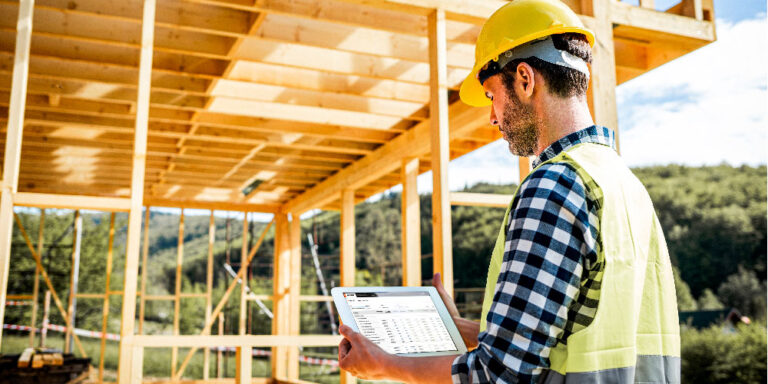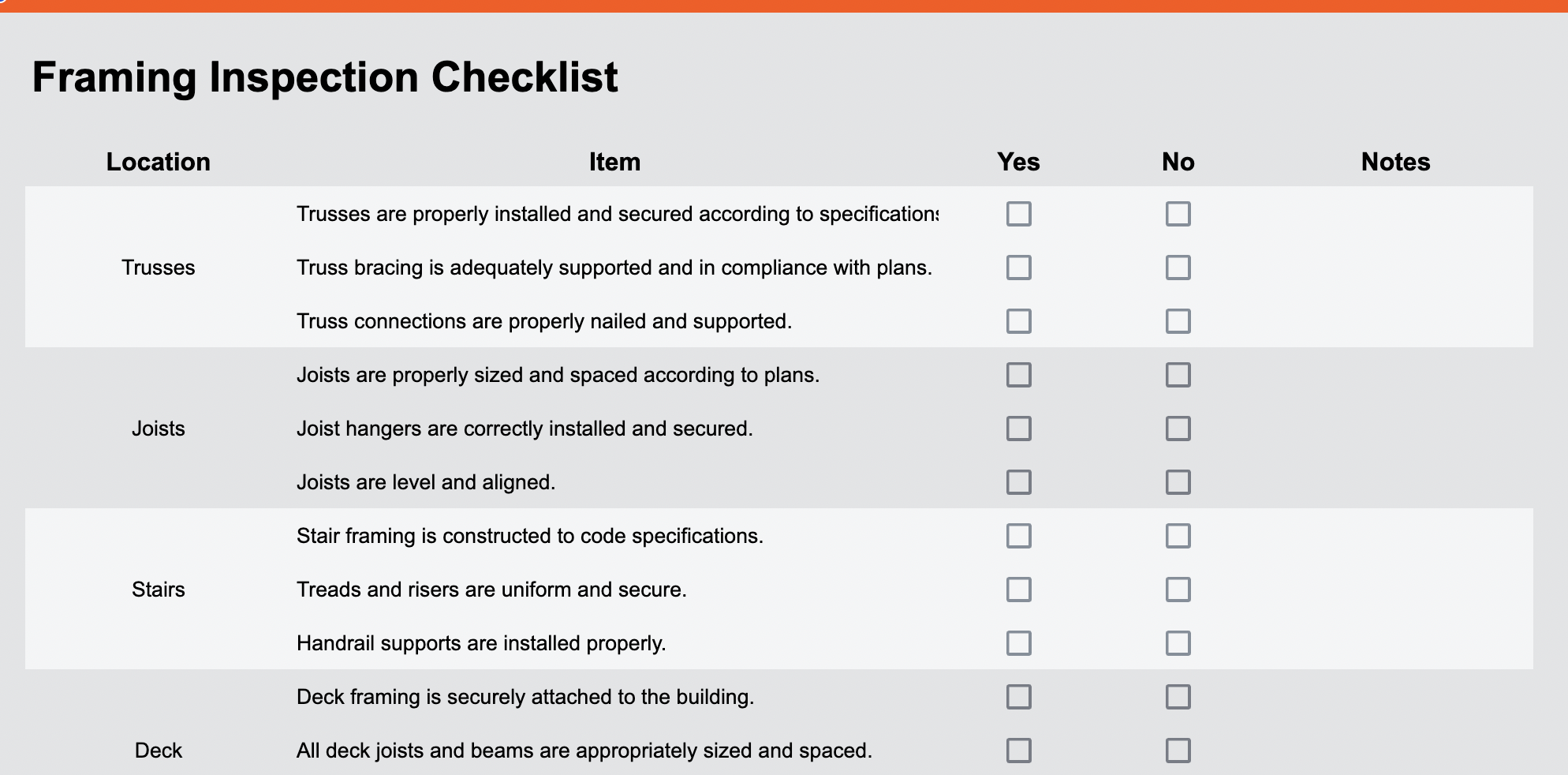— 7 min read
Framing Inspections: What to Expect & How to Prepare




Last Updated Sep 22, 2025

D. Jesse Mase
Principle Operational Excellence Specialist
10 articles
D. Jesse Mase has a wealth of experience spanning architecture, construction, and real estate investment. His passion for the built environment led him to self-employment as a design builder, and later, managing large-scale commercial construction projects at Trehel Corporation. Currently, Jesse leverages his industry insights in his role as Principal Strategic Product Consultant at Procore, streamlining processes and solutions for construction project owners.

Cait Bladt
13 articles
Cait Bladt is a multi-award winning freelance writer and producer. Her work has appeared at Vice, ABC News and Rolling Stone among others. She currently lives in Brooklyn with her cat Patricia.

Anthresia McWashington
Content Manager
20 articles
Anthresia McWashington is a Content Manager at Procore. She previously worked as an editor and reporter for Gulf Energy Information and Houston Media Group. She earned her BA in Communications and Journalism from the University of Houston. Anthresia loves track & field and practicing her French. She lives in Houston.

Julia Tell
Contributing Writer
64 articles
Julia Tell is a freelance writer covering education, construction, healthcare, and digital transformation. She holds a Ph.D. in Media & Communications and has written for publications including Business Insider, GoodRx, and EdSurge, as well as nonprofits, international businesses, and educational institutions.
Last Updated Sep 22, 2025

Framing inspections assess a building's frame and components, making sure they are installed correctly and comply with safety codes and regulations established by local authorities having jurisdiction (AHJs). These inspections could either be a combination inspection, where framing, mechanical, electrical and plumbing (MEP) are all assessed together, or a singular framing inspection.
This article will discuss the importance of framing inspections, what to expect and how to be best prepared for inspections in the future.
Table of contents
What is a framing inspection?
A framing inspection, sometimes called a rough-in inspection, is a step in the construction process to check the structural integrity of a building’s frame and other components. This inspection is intended to confirm that the framing — the building’s skeleton of walls, floors, and roof structures — complies with building codes, design specifications, and safety standards.
Typically performed by a qualified inspector, the process involves examining all framing components, such as beams, studs, joists and trusses, to verify that they are correctly installed and securely fastened.
The inspector also checks that the layout matches architectural plans and that materials and techniques used meet required standards. A successful framing inspection enables subsequent construction phases to proceed and helps keep the project on schedule.
Framing Inspections Basics
The International Building Code and International Residential Code set standards for inspections on commercial and residential buildings in the U.S. Inspections, typically enforced by local AHJs, take place during the permitting phase of the project and include framing, electrical and mechanical inspections. General contractors should be on top of all code requirements and changes in codes in order to keep their projects in compliance.
Local AHJs that are responsible for enforcing codes may vary by location and type of building. For example, schools might have a different inspector than office buildings within the same county. Sometimes, inspectors are direct employees of the AHJ, while other times they are third-party inspectors.
For residential projects, AHJ staff inspectors often perform framing inspections, which might be combined with MEP inspections. Commercial inspections are usually more specialized, with separate inspections for framing, mechanical, plumbing and electrical systems. Because of their size and amount of equipment that is installed, commercial projects generally involve more steps, checklists and inspections.
Pro Tip
Common failures with framing inspections include oversized cuts and holes, water intrusion through windows or roofs, and problems with load paths and uplift connectors. For example, people often cut too big of a hole out of a floor system or roof system, which can compromise the structure.
When to Schedule a Frame Home Inspection
The simple answer is: After mechanicals — HVAC, electrical, and plumbing — have been roughed in, but before any insulation or wall coverings have been installed. Inspectors need to verify that the rough-ins have not compromised the structural integrity of the framing and require access to all framing elements before they are covered by drywall. The roofing and exterior moisture barriers should be in place before a framing inspection.
Some jurisdictions may require inspection of the plumbing and electrical rough-ins before a framing inspection, while others will perform both inspections at the same time. Check with the relevant AHJ for the sequence of inspections and exact requirements.
Preparing for Framing Inspections
One of the most important aspects of preparing for inspections is conducting internal pre-inspections throughout construction. Superintendents should have a standardized, repeatable framework or template for pre-inspections, allowing their team, and any specialty contractors hired, to easily identify and address potential issues beforehand.
By doing this, builders can avoid calling for an inspection before being fully prepared, which can lead to messy inspections and potential issues with the schedule. Since some initial inspections may also incur fees, it’s important that use their pre-inspections time to go over the completed work with a fine-tooth comb.
Contractors should also plan for inspections to take weeks – or even months, to be scheduled. Project leadership should build a contingency plan in their schedule that is fully communicated to the entire team to avoid issues.
For example, some framing inspectors won’t pass a building if the framing is covered by sheetrock. Therefore, all teams need to have the sheetrock delivered but must wait until the inspection is complete to install it.
Rushing and tight scheduling can lead to a strained relationship with the inspector. On top of that, if the inspection fails, it could lead to missed deadlines, rework or additional costs due to delays.
Incorporating buffer times or "will call" scheduling helps more effectively manage resources and avoid unnecessary headaches.
Stay updated on what’s happening in construction.
Subscribe to Blueprint, Procore’s free construction newsletter, to get content from industry experts delivered straight to your inbox.

Expectations for Framing Inspections
When working with county inspectors, assignments are random, which means there can be massive differences in the temperament and approach of each inspector. Some inspectors are known for being particularly strict or difficult.
Some builders choose not to be present during the inspection, preferring to address issues later to avoid confrontation. Builders who get combative or argue about issues inspectors find can provoke stricter scrutiny from inspectors.
The best way to handle an inspection is to walk through the site with the inspector, making notes on all issues they find, and fixing issues immediately if possible. Having labor on-site during inspections to address any minor issues quickly can go a long way in passing an inspection.
Contractors sometimes choose to overstaff and have materials ready to address any immediate concerns raised by the inspector. A generous inspector may stay onsite while an issue is being fixed and could turn a failing inspection into a passing one.
When dealing with third-party inspectors, builders often encounter the same small group of inspectors, allowing for the development of a working relationship. These inspectors can act more like consultants, providing suggestions on how to meet code requirements rather than merely pointing out violations.
If an inspection fails, inspectors will cite specific code violations but won't prescribe fixes, which means the project must then be re-inspected. Re-inspection fees may apply, especially after multiple failures. Delays in passing inspections can lead to increased costs due to extended project timelines and potential liquidated damages.
In some situations, the building’s design team may be consulted about issues noted by inspectors. Occasionally, the designers will be able to justify choices that have been made in the building’s framing and AHJs may decide to override the inspector.
Using a Framing Inspection Checklist
A framing inspection checklist can help contractors prepare so that the inspection proceeds smoothly and keeps the project on schedule.
Free Download
Framing Inspection Checklist
Use this framing inspection checklist to create a personalized list of inspection items. It includes suggested elements inspectors have an eye out for and room for notes.
- Free starter template
- Ready-to-use with room for customization
- Trusted by construction professionals


Key Components and Areas That Inspectors Evaluate
All materials and hardware must match specifications and meet applicable codes. Key components and areas that inspectors evaluate include:
- Foundation Anchors: Properly placed to secure the framing to the foundation
- Wall Studs: Correctly spaced and aligned for structural stability
- Top and Bottom Plates: Securely fastened and aligned correctly
- Headers and Beams: Adequately sized and installed to support loads
- Floor Joists: Spacing and installation to support level and secure flooring
- Roof Trusses: Correctly installed and braced for roof support
- Sheathing: Wall and roof sheathing properly installed and fastened
- Nail Patterns: Spaced and driven according to design specifications
- Fire Blocking: Presence and proper installation of fire blocking materials
- Bracing and Lateral Support: Adequate bracing is in place to prevent lateral movement
- Moisture Barriers: Proper installation of any required moisture barriers
- Openings for Doors and Windows: Correctly framed and sized
- Stair Framing: Accurate dimensions and secure attachment
- Bearing Walls: Correctly identified and constructed
- Ceiling Joists: Properly installed to support ceiling loads
- Truss Connections: Secure and meet engineering requirements
- Utility Openings: Do not compromise structural integrity
Adequate preparation leads to seamless inspections.
Builders can help put themselves in the best position possible with inspectors by ensuring they have prepared as much as possible throughout the building process. Incorporating digital tools to assist with the inspection process can also set construction companies up for success.
One of the things that happened that's happened in the last ten, twenty years has been that a lot of jurisdictions have moved to digital permit management platforms. This helps a ton. It's not helping me not fail, but it is helping me have a means of requesting and tracking and following up on where am I at and what my actual status is.

D. Jesse Mase
Principle Operational Excellence Specialist
Procore Technologies
Showing respect, asking questions and seeking inspectors' suggestions can also lead to a better inspection process and help build a positive rapport between builders, inspectors and AHJs. By confirming that buildings are up-to-code and doing solid, careful work, owners and builders can save themselves time and money.
Was this article helpful?
Thank you for your submission.
67%
33%
You voted that this article was . Was this a mistake? If so, change your vote
Scroll less, learn more about construction.
Subscribe to The Blueprint, Procore’s construction newsletter, to get content from industry experts delivered straight to your inbox.
By clicking this button, you agree to our Privacy Notice and Terms of Service.
Thank you!
You’re signed up to receive The Blueprint newsletter from Procore. You can unsubscribe at any time.
Categories:
Written by

D. Jesse Mase
Principle Operational Excellence Specialist | Procore Technologies
10 articles
D. Jesse Mase has a wealth of experience spanning architecture, construction, and real estate investment. His passion for the built environment led him to self-employment as a design builder, and later, managing large-scale commercial construction projects at Trehel Corporation. Currently, Jesse leverages his industry insights in his role as Principal Strategic Product Consultant at Procore, streamlining processes and solutions for construction project owners.
View profile
Cait Bladt
13 articles
Cait Bladt is a multi-award winning freelance writer and producer. Her work has appeared at Vice, ABC News and Rolling Stone among others. She currently lives in Brooklyn with her cat Patricia.
View profile
Anthresia McWashington
Content Manager | Procore
20 articles
Anthresia McWashington is a Content Manager at Procore. She previously worked as an editor and reporter for Gulf Energy Information and Houston Media Group. She earned her BA in Communications and Journalism from the University of Houston. Anthresia loves track & field and practicing her French. She lives in Houston.
View profile
Julia Tell
Contributing Writer | Procore Technologies
64 articles
Julia Tell is a freelance writer covering education, construction, healthcare, and digital transformation. She holds a Ph.D. in Media & Communications and has written for publications including Business Insider, GoodRx, and EdSurge, as well as nonprofits, international businesses, and educational institutions.
View profileExplore more helpful resources

Avoiding The App Trap: Overcome Financial Silos to Connect Field & Office
For general contractors working on razor-thin margins, rework and project delays are more than simple inefficiencies — they are major threats to the bottom line. For years, GCs have attempted...

Profit from Predictability: Construction Software as a Business Strategy
For general contractors, managing complex, multi-million-dollar projects, every project phase — from planning and budgeting to on-site execution — is an opportunity to lose time and money. Construction software is...

Defending Against Financial & Legal Risks on Megaprojects
The construction industry has seen marked growth in megaprojects. Some experts classify any project over $500 million as a megaproject, while others argue that the build needs to be $1...

Unlocking Project Intelligence: Moving from Raw Data to Actionable Insights
The construction industry faces a wide range of challenges, from ongoing labor shortages to frequent cost overruns. But some the biggest hurdles all stem from unpredictability. The general contractors (GCs)...
Free Tools
Calculators
Use our calculators to estimate the cost of construction materials for your next project.
Templates
Find a template to help you with your construction project tasks.
Material Price Tracker
Get the latest U.S. retail prices and view historical trends for common building materials.
Glossary
Explore key terms and phrases used in the industry.
